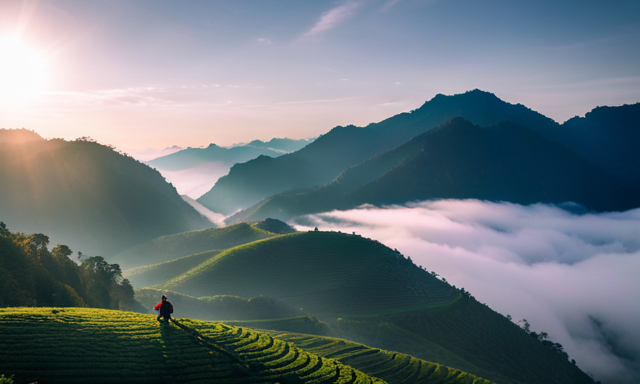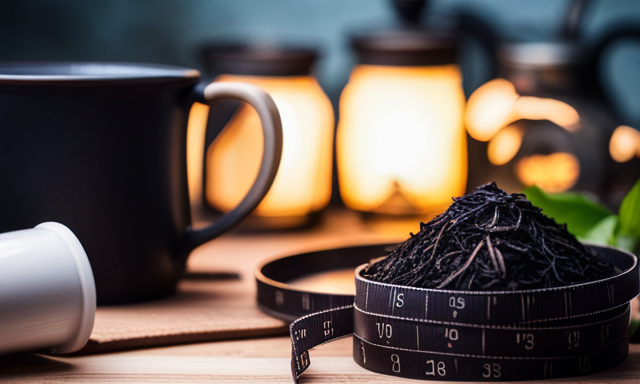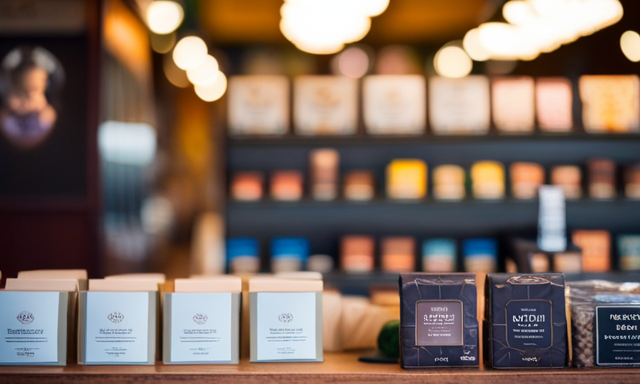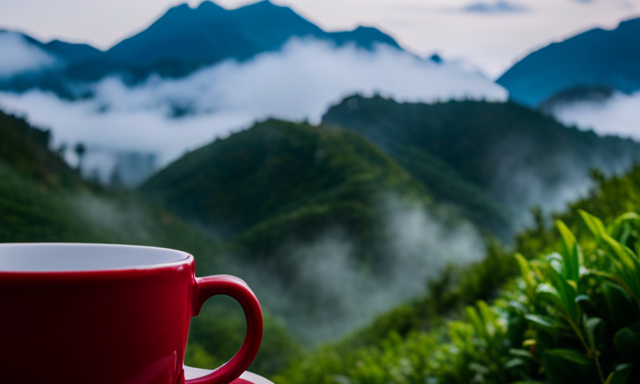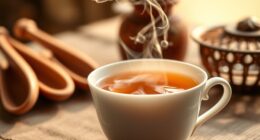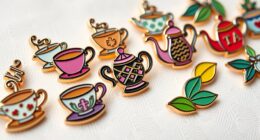Coincidentally, my journey into the world of tea began with a chance encounter with a steaming cup of oolong tea. As the fragrant aroma enveloped my senses and the rich, complex flavors danced on my palate, I was instantly captivated by this enigmatic beverage. It left me with a burning curiosity, a desire to unravel the origins and secrets of oolong tea. So, join me as we embark on a quest to discover the roots of this magnificent tea.
Oolong tea, with its distinct flavor and unique characteristics, has a history that stretches back centuries. Originating in the lush tea-growing regions of China and Taiwan, oolong tea is a true testament to the artistry and skill of its cultivators. From the meticulously hand-picked leaves to the intricate process of oxidation and withering, every step in the production of oolong tea is carefully orchestrated to create a beverage that is both delicate and robust.
So, let us delve into the depths of this captivating drink and uncover the secrets of where oolong tea truly comes from.
Key Takeaways
- Oolong tea originates from the Fujian province in China.
- Traditional tea-making techniques in Fujian shape the taste and aroma of oolong tea.
- Oolong tea thrives in regions with moderate temperatures, high humidity, and well-drained soil.
- Different oxidation levels result in various flavor profiles of oolong tea.
The Origins of Oolong Tea
Oolong tea, with its rich history and unique flavor, originates from the Fujian province in China. This region has a deep-rooted connection to tea production, making it the perfect birthplace for such a remarkable brew.
The historical significance of oolong tea in Fujian is undeniable. It has been cultivated and enjoyed for centuries, becoming an integral part of the local culture. The Fujian province is known for its traditional tea-making techniques, which have been passed down through generations. These cultural traditions play a vital role in shaping the distinct taste and aroma of oolong tea.
From the meticulous hand-picking of tea leaves to the precise oxidation process, every step involved in the production of oolong tea is carefully executed to ensure its exceptional quality.
Moving on to the cultivation of oolong tea, the journey continues with the careful nurturing of tea plants.
The Cultivation of Oolong Tea
To cultivate Oolong tea, you’ll need to carefully select the right growing conditions and employ specific harvesting methods.
Cultivation techniques for Oolong tea involve finding the ideal climate, altitude, and soil conditions. The tea plants thrive in regions with moderate temperatures, high humidity, and well-drained soil.
The harvesting process is crucial in determining the flavor and quality of the tea. Only the topmost leaves and buds are plucked by hand, ensuring that only the finest leaves are used. This meticulous picking method allows for the perfect balance of flavors in the tea.
Once harvested, the leaves are carefully processed through withering, oxidation, and firing to create the distinct flavors and aromas that Oolong tea is known for. The unique flavor profiles of Oolong tea are a result of the intricate cultivation and harvesting techniques used.
The Unique Flavor Profiles of Oolong Tea
The distinct flavor profiles of Oolong tea are a harmonious blend of floral, fruity, and toasty notes, enticing the senses with every sip. This unique taste is achieved through a combination of factors, including the tea leaves used in Oolong tea and the oxidation process it undergoes. Oolong tea is made from a specific variety of Camellia sinensis leaves, which are carefully selected for their quality and flavor potential. These leaves are then subjected to a partial oxidation process, which sets Oolong tea apart from green and black teas. The oxidation level of Oolong tea can vary, resulting in different flavor profiles. Some Oolong teas have a more floral and delicate taste, while others are more robust and toasty. These variations make Oolong tea a versatile choice for tea enthusiasts. Moving on to the health benefits of Oolong tea…
The Health Benefits of Oolong Tea
One cannot deny the myriad health benefits that Oolong tea brings to those who regularly enjoy this flavorful beverage.
Oolong tea is well-known for its weight loss benefits. It contains polyphenols that activate enzymes to enhance fat metabolism, helping to reduce obesity and promote weight loss.
Additionally, the antioxidant properties of oolong tea are impressive. It is rich in catechins, which are powerful antioxidants that help fight free radicals in the body, reducing the risk of chronic diseases such as heart disease and cancer.
The combination of these health benefits makes oolong tea a smart choice for those looking to improve their overall well-being.
Moving on to the different types of oolong tea, each variety offers its own unique flavor profile and characteristics.
The Different Types of Oolong Tea
When it comes to oolong tea, there are two main categories that are worth exploring: Traditional Chinese Oolong Varieties and Taiwanese Oolong Varieties.
Traditional Chinese Oolong Varieties include famous teas like Tie Guan Yin and Da Hong Pao, which are known for their complex flavors and rich aromas.
On the other hand, Taiwanese Oolong Varieties, such as Dong Ding and Alishan, are known for their smooth and floral profiles, offering a delightful drinking experience.
Traditional Chinese Oolong Varieties
Imagine walking through the lush tea fields of traditional Chinese oolong varieties, with their aromatic leaves gently swaying in the breeze and captivating your senses.
Traditional Chinese oolong teas are known for their unique tea processing techniques and oolong tea production methods. These teas are meticulously crafted using centuries-old traditions, resulting in flavors that are rich, complex, and deeply satisfying.
The leaves are carefully plucked by hand, ensuring only the highest quality leaves are used.
After being plucked, the leaves undergo a partial oxidation process, which gives oolong tea its characteristic taste.
The leaves are then skillfully rolled into tight, twisted shapes, allowing for maximum flavor extraction during brewing.
Each step in the production of traditional Chinese oolong teas is done with utmost care and precision, resulting in teas that are truly exceptional.
Now, let’s delve into the fascinating world of Taiwanese oolong varieties.
Taiwanese Oolong Varieties
Taiwanese oolong varieties are renowned for their exceptional flavors and aromas. The unique climate and fertile soil of Taiwan provide the perfect conditions for growing high-quality tea leaves. These teas are characterized by their complex and nuanced flavors, ranging from floral and fruity to woody and roasted. They are meticulously crafted using traditional methods, such as hand-rolling and sun withering, to bring out the best qualities in each leaf.
In addition to their traditional uses, Taiwanese oolong teas have also found their way into modern recipes. They add depth and complexity to dishes like ice cream, pastries, and cocktails. Now, let’s delve into the art of brewing oolong tea.
The Art of Brewing Oolong Tea
When it comes to brewing oolong tea, two key factors to consider are water temperature and steeping time. The water temperature should be around 190-200°F, which is just below boiling point, to properly extract the flavors and aromas of the oolong leaves.
Steeping time can vary depending on personal preference, but generally, 3-5 minutes is a good range for oolong tea.
Teaware also plays a crucial role in brewing oolong tea. Traditional teapots made from clay or porcelain are ideal for preserving the delicate flavors of oolong tea.
Additionally, infusion techniques such as multiple steepings can enhance the complexity of the tea. By pouring the water in quick, successive pours, the tea leaves can unfold and release their flavors more gradually, resulting in a more nuanced and enjoyable cup of oolong tea.
Water Temperature and Steeping Time
To achieve the perfect balance of flavor, steep your oolong tea for 3 minutes in water heated to 180°F, allowing the leaves to unfurl and release their intricate flavors, much like a delicate flower blossoming in the morning sun. The water temperature and steeping time are crucial in bringing out the best qualities of oolong tea. The ideal water temperature of 180°F helps to preserve the delicate flavors and aromas, allowing the tea leaves to gradually infuse into the water. Steeping for 3 minutes strikes the right balance, extracting the rich flavors without overbrewing and resulting in a bitter taste. To help you visualize the importance of water temperature and steeping time, take a look at the table below:
| Water Temperature | Steeping Time |
|---|---|
| 180°F | 3 minutes |
Now, let’s delve into the next section about teaware and infusion techniques, where we explore the art of enhancing oolong tea’s flavors even further.
Teaware and Infusion Techniques
Now that we’ve discussed the importance of water temperature and steeping time in brewing the perfect cup of oolong tea, let’s move on to the next crucial aspect: teaware and infusion techniques.
The choice of teaware can greatly impact the flavor and aroma of oolong tea. There are various teaware styles available, such as porcelain, Yixing clay, and glass. Each style has its own unique qualities that can enhance the tea-drinking experience.
Additionally, the infusion technique plays a vital role in bringing out the rich flavors of oolong tea. Whether it’s a gongfu-style steeping method or a simple pot brewing technique, the goal is to extract the full essence of the tea leaves.
By using the right teaware and mastering the infusion techniques, you can truly appreciate the intricate flavors and nuances of oolong tea.
Now, let’s delve into the cultural significance of this remarkable beverage.
The Cultural Significance of Oolong Tea
Tea ceremonies and rituals have played a significant role in many cultures throughout history. Oolong tea has been a staple in these traditions. The art of brewing and serving oolong tea is seen as a form of meditation. Each step is carefully executed to create a harmonious experience.
In addition, oolong tea has also been used in traditional medicine. It offers numerous health benefits, such as aiding digestion, promoting weight loss, and improving mental alertness.
Its rich history and cultural significance make oolong tea a truly remarkable beverage.
Tea Ceremonies and Rituals
Originating in East Asia, oolong tea is often associated with elegant tea ceremonies and rituals. Tea ceremonies have deep roots in Chinese and Japanese cultures. They serve as a means to showcase hospitality, respect, and harmony. These ceremonies involve intricate rituals, such as the precise measurement of tea leaves, the careful selection of tea utensils, and the graceful pouring of hot water.
Each step is performed with utmost precision and mindfulness, creating a serene and meditative atmosphere. Tea rituals emphasize the importance of mindfulness and the appreciation of the present moment. They provide a space for individuals to connect with themselves and others, fostering a sense of tranquility and unity.
Moving forward to the next section on oolong tea in traditional medicine, it is important to understand the historical and cultural significance of this ancient beverage.
Oolong Tea in Traditional Medicine
Oolong tea in traditional medicine is steeped in centuries of tradition and has long been hailed as a healing elixir, weaving its medicinal magic into the tapestry of ancient Eastern cultures.
Oolong tea is highly regarded in traditional medicine for its numerous health benefits. It is believed to aid digestion, boost metabolism, and promote weight loss.
This tea is also known for its ability to regulate blood sugar levels and improve heart health. Additionally, the antioxidants found in oolong tea can help reduce the risk of chronic diseases and enhance overall well-being.
Its traditional medicine applications make it a popular choice among those seeking natural remedies.
As we transition into the subsequent section about the global popularity of oolong tea, it becomes evident that its healing properties have contributed to its widespread appeal worldwide.
The Global Popularity of Oolong Tea
Oolong tea has gained significant popularity in Western countries over the past few decades. Its unique flavor profile, which falls between that of black and green tea, has captivated the palates of tea enthusiasts. Additionally, the numerous health benefits associated with oolong tea, such as improved digestion and weight management, have contributed to its growing demand in the West.
In Asian cultures, oolong tea has a long-standing tradition and holds a special place in daily life. In countries like China and Taiwan, oolong tea is not just a beverage but a symbol of hospitality, respect, and social connection. It is often served during important events and gatherings, and the art of preparing and serving oolong tea is highly valued and passed down through generations.
The global popularity of oolong tea can be attributed to its ability to bridge cultural gaps and appeal to a wide range of tastes. Whether enjoyed in a traditional tea ceremony or in a cozy café in the West, oolong tea offers a delightful experience that transcends borders and brings people together through the shared love for this remarkable tea.
Oolong Tea in Western Countries
Oolong tea has gained popularity in Western countries due to its unique flavor profile and rich history. Its consumption has increased significantly in recent years as people have started to appreciate its exquisite taste and numerous health benefits.
Here are five reasons why oolong tea has become a favorite in the West:
-
Oolong tea’s delicate and complex flavors offer a refreshing alternative to traditional black or green teas.
-
Many coffee shops now offer oolong tea on their menus, attracting a broader customer base.
-
Oolong tea’s reputation as a metabolism booster has made it popular among those seeking to maintain a healthy weight.
-
The high antioxidant content in oolong tea has caught the attention of health-conscious individuals.
-
Oolong tea’s calming properties and ability to aid digestion have made it a preferred choice for relaxation and after-meal enjoyment.
As oolong tea gains popularity in Western countries, it’s worth exploring its deep-rooted significance in Asian cultures.
Oolong Tea in Asian Cultures
Ironically, the cultural significance of oolong tea in Asia goes far beyond its popularity in Western countries.
In Japanese culture, oolong tea is known as ‘oolong-cha’ and is highly valued for its unique flavor and health benefits. It is often served during traditional tea ceremonies, where the art of brewing and appreciating tea is celebrated.
Similarly, in Korean culture, oolong tea, known as ‘oolong-sucha,’ is deeply ingrained in daily life. It is enjoyed throughout the day and is believed to have various medicinal properties.
Oolong tea is not just a beverage in these cultures, but a symbol of hospitality, respect, and connection to nature.
Moving on to the subsequent section about sustainable practices in oolong tea production, it is crucial to address the environmental impact of this beloved tea.
Sustainable Practices in Oolong Tea Production
When it comes to sustainable practices in oolong tea production, two key points to consider are organic and fair trade certifications, as well as environmental conservation initiatives.
Organic certifications ensure that the tea is grown without the use of harmful chemicals or pesticides, promoting a healthier environment and product.
Fair trade certifications guarantee that the tea is produced under fair labor conditions and that the farmers receive a fair price for their hard work.
Additionally, environmental conservation initiatives aim to protect and preserve the natural resources and habitats involved in oolong tea production, contributing to a more sustainable and responsible industry.
Organic and Fair Trade Certifications
Did you know that oolong tea can be certified organic and fair trade? This ensures that it is not only delicious but also sustainably sourced.
Organic farming is an important aspect of oolong tea production. It involves growing the tea leaves without the use of synthetic fertilizers, pesticides, or genetically modified organisms. This promotes the health of the soil, water, and surrounding ecosystems.
Fair trade practices, on the other hand, focus on ensuring that the tea is produced under ethical conditions. This includes fair wages and safe working conditions for farmers and workers.
These certifications guarantee that the oolong tea you enjoy has been produced in a way that prioritizes both environmental and social sustainability.
Moving on to environmental conservation initiatives, let’s explore the efforts made to protect the natural habitats where oolong tea is grown.
Environmental Conservation Initiatives
Moving on from the discussion about organic and fair trade certifications, let’s delve into the environmental conservation initiatives surrounding oolong tea production. As a tea enthusiast, I am pleased to see that sustainable farming techniques and wildlife conservation efforts are gaining momentum in the tea industry. Producers are increasingly adopting practices that minimize environmental impact while ensuring the long-term viability of their tea gardens. Through sustainable farming techniques such as organic fertilizers, natural pest control, and water conservation methods, oolong tea farmers are prioritizing the health and preservation of the land. Additionally, many tea estates are now actively involved in wildlife conservation efforts, creating protected areas within their gardens to safeguard the habitats of native species. These initiatives not only contribute to the well-being of the environment but also result in the production of high-quality oolong teas that are both flavorful and responsibly sourced. Transitioning to the next section, let’s now explore new trends and innovations in the world of oolong tea.
Exploring New Trends and Innovations in Oolong Tea
While exploring new trends and innovations in oolong tea, it’s fascinating how this traditional beverage continues to evolve and captivate tea enthusiasts worldwide.
One of the most exciting developments is the exploration of new flavors in oolong tea. Traditionally, oolong tea is known for its unique balance of floral and fruity notes, but now, tea producers are experimenting with different flavor profiles. From creamy and nutty to citrusy and spicy, the possibilities are endless.
Additionally, oolong tea is making its way into modern cuisine. It is being used in innovative ways, such as infused in cocktails, incorporated into desserts, and even used as a flavoring agent in savory dishes. This infusion of oolong tea into the culinary world adds a delightful twist to traditional recipes and enhances the overall dining experience.
As oolong tea continues to push boundaries and explore new horizons, it solidifies its position as a versatile and beloved beverage.
Frequently Asked Questions
What is the caffeine content in oolong tea compared to other types of tea?
The caffeine content in oolong tea is higher than in black tea but lower than in green tea. As for pregnant women, it is generally safe to consume oolong tea in moderate amounts.
Can oolong tea help with weight loss?
Oolong tea has been shown to help with weight loss by regulating blood sugar levels and improving digestion and metabolism. It is a natural and effective way to support weight management.
How long does it take to brew the perfect cup of oolong tea?
To brew the perfect cup of oolong tea, it typically takes 3-5 minutes. The brewing techniques may vary depending on the oolong tea variety, but it’s important to follow the instructions provided with the tea for optimal results.
Does oolong tea have any known side effects?
Oolong tea, with its mesmerizing flavors, offers numerous health benefits. However, it’s important to be aware of potential side effects. While generally safe, excessive consumption may lead to digestive issues or caffeine sensitivity.
Are there any special storage requirements for oolong tea to maintain its flavor and quality?
To maintain the flavor and quality of oolong tea, special storage conditions are necessary. It should be stored in a cool, dark, and dry place, away from sunlight, moisture, and strong odors.
Conclusion
In conclusion, oolong tea is a fascinating beverage that has captivated tea enthusiasts for centuries. Its origins can be traced back to the mountains of China, where skilled farmers use sustainable practices to cultivate the finest leaves.
The unique flavor profiles of oolong tea, ranging from floral and fruity to roasted and earthy, are a delight to the senses. With its numerous health benefits and cultural significance, oolong tea has become a global sensation, like a symphony of flavors dancing on your palate.
As new trends and innovations continue to emerge, the future of oolong tea looks as bright as the morning sun.

